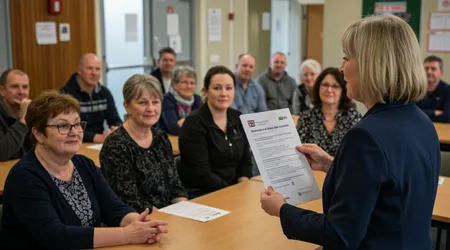UK MP Proposes Law to Protect Community Sports Facilities

Community Sports Assets are the heartbeat of local economies, fostering health, unity, and pride.
In 2025, a groundbreaking proposal by UK MP Emma Foody aims to protect these vital spaces by classifying sports facilities as Assets of Community Value (ACVs).
This law could reshape how communities invest in and preserve their recreational hubs, with profound financial implications.
From grassroots football pitches to leisure centres, the initiative addresses the growing threat of privatization and closure.
This article explores the financial stakes, community benefits, and economic ripple effects of this visionary legislation, offering a fresh perspective on why protecting Community Sports Assets matters now more than ever.
The urgency of this proposal stems from a stark reality: local sports facilities are vanishing. Budget cuts and developer pressures have left many communities stripped of spaces that nurture physical and social well-being.
Foody’s bill, backed by the Co-operative Party, seeks to empower locals to claim ownership of these assets, ensuring they remain accessible.
By weaving financial strategy with social good, this law could redefine community resilience.
Let’s dive into the economic case, practical impacts, and broader significance of safeguarding Community Sports Assets.
The Economic Case for Protecting Community Sports Assets
Sports facilities drive local economies in ways often overlooked. Community Sports Assets generate revenue through memberships, events, and tourism, while boosting nearby businesses.
A 2023 Sport England report found that community sports contribute £85 billion annually to the UK economy. Yet, closures threaten this engine.
Foody’s bill proposes automatic ACV status for sports venues, giving communities first refusal if sold.
This financial safeguard prevents asset-stripping by developers. When a leisure centre closes, local spending drops cafes and shops suffer.
]By preserving Community Sports Assets, the law ensures steady economic activity. Imagine a small town’s football pitch hosting weekly matches, drawing crowds to local pubs.
The ripple effect is clear: protect the pitch, protect the pub.
Moreover, ACV status attracts investment. Community trusts can access grants to maintain facilities, reducing reliance on strained council budgets.
++ FCA’s Five-Year Strategy: What It Means for UK Consumers and Firms
This model shifts financial responsibility to empowered locals, fostering sustainable growth. The bill’s genius lies in its dual focus: economic stability and community ownership.
Consider the case of a Bristol swimming pool saved by residents in 2024. After council cuts threatened closure, locals formed a trust, secured funding, and now run a thriving hub.
This success story underscores the bill’s potential to unlock financial resilience through Community Sports Assets.

Financial Risks of Losing Community Sports Facilities
Neglecting Community Sports Assets carries steep economic costs. Closed facilities burden public health systems, as inactivity fuels obesity and mental health issues.
The NHS spends £7 billion annually on obesity-related illnesses, much of which could be mitigated by accessible sports venues. Foody’s bill tackles this by prioritizing community access over profit-driven sales.
Local job losses are another risk. Sports centres employ coaches, cleaners, and administrators.
When they shutter, unemployment rises, and council tax revenues dip. Protecting Community Sports Assets preserves these roles, stabilizing local economies.
Picture a shuttered gym in Leeds: workers lose jobs, and nearby cafes lose customers. The domino effect is devastating.
Also read: Financial Benchmarking Tool Launches for UK Schools
The bill also counters speculative land grabs. Developers often buy sports facilities for housing, eroding community wealth.
ACV status delays such sales, giving locals time to bid. This protects long-term economic value over short-term developer profits, ensuring Community Sports Assets remain community-owned.
In 2024, a Manchester cricket ground faced demolition for flats. Community protests and ACV listing halted the sale, preserving jobs and local pride.
Foody’s law would make such victories standard, safeguarding economic ecosystems tied to sports.
Community Ownership: A Financial Paradigm Shift
Foody’s proposal reimagines how Community Sports Assets are funded and managed. By granting ACV status, communities gain legal tools to buy and operate facilities.
This shifts financial power from councils to residents, fostering innovative funding models. Crowdfunding, social bonds, and grants become viable, reducing public sector strain.
Take the example of a fictional Yorkshire village, Greenvale. Its tennis courts faced closure due to council cuts.
Read more: FCA Targets Financial Crime: New Initiatives for 2025/26
Residents crowdfunded £50,000, secured a grant, and now run a profitable club.
This mirrors real cases where community ownership cuts costs and boosts revenue. Foody’s bill would streamline such efforts.
This model also mitigates financial risk. Community trusts are less likely to mismanage assets than distant corporations.
Local accountability ensures funds are reinvested, not siphoned off. By embedding Community Sports Assets in community hands, the bill creates a self-sustaining financial cycle.
The Co-operative Party’s support highlights this shift. Their model emphasizes shared ownership, aligning with the bill’s ethos.
In 2025, as councils face budget crises, community-led finance offers a lifeline, ensuring sports facilities thrive without taxpayer burden.
table: Economic Impact of Community Sports Assets
| Economic Impact of Community Sports Assets | Details |
|---|---|
| Annual Contribution to UK Economy | £85 billion (Sport England, 2023) |
| NHS Obesity-Related Costs | £7 billion annually |
| Jobs Supported by Sports Facilities | Coaches, administrators, cleaners |
| Tourism Revenue | Events like marathons inject millions |
Broader Economic and Social Ripple Effects
The financial benefits of protecting Community Sports Assets extend beyond local economies. Healthy communities reduce healthcare costs, easing national budgets.
Sports facilities also attract tourism, as seen with events like the London Marathon, which injects millions into the economy. Foody’s bill ensures smaller venues share this prosperity.
Social cohesion is another economic driver. Sports clubs unite diverse groups, reducing crime and fostering inclusion.
Lower crime rates save policing costs, indirectly bolstering public finances. By safeguarding Community Sports Assets, the bill invests in social capital, yielding long-term savings.
Consider a rugby club in Cardiff. It hosts youth programs, keeping teens off streets and building skills. The economic value of reduced crime and employable youth is immense.
Foody’s law would protect such clubs, amplifying their financial and social impact.
The bill also aligns with 2025’s economic trends. As remote work grows, local amenities like sports centres become community anchors, drawing residents to spend locally.
Protecting these assets ensures towns remain vibrant, not ghost towns.
Challenges and Counterarguments
No legislation is without hurdles. Critics argue that managing Community Sports Assets burdens communities with financial risks.
Small trusts may lack expertise to run complex facilities, potentially leading to losses. Foody’s bill must include training and support to counter this.
Another concern is funding. While grants exist, securing them is competitive. Communities in poorer areas may struggle, deepening inequalities.
The bill needs mechanisms to prioritize disadvantaged regions, ensuring equitable access to Community Sports Assets.
Developers also pose a challenge. They may lobby against ACV status, claiming it stifles housing growth.
Yet, housing can coexist with sports facilities mixed-use developments are a proven model. Foody’s team must counter this narrative with data-driven arguments.
Despite these challenges, the bill’s benefits outweigh risks. With proper support, communities can manage assets effectively.
The economic and social gains of preserving Community Sports Assets far surpass the costs of inaction.
A Vision for the Future

Foody’s bill is a financial masterstroke, blending economic foresight with social good. By protecting Community Sports Assets, it empowers communities to control their financial destiny.
The law could inspire similar protections for libraries or parks, creating a broader asset-protection framework. What’s stopping us from reimagining community wealth entirely?
This legislation also sets a global precedent. Countries like Australia face similar facility closures.
The UK’s model could spark international reforms, positioning Britain as a leader in community-driven economics. The financial stakes are high, but so is the potential.
Imagine a future where every town has a thriving sports hub, funded by locals, not corporations. Jobs, health, and pride flourish.
Foody’s bill is the first step toward this reality, proving that Community Sports Assets are worth fighting for.
Conclusion: Investing in Community Wealth
Emma Foody’s proposal to protect Community Sports Assets is more than a law it’s a financial revolution.
By empowering communities to own their sports facilities, it safeguards local economies, jobs, and health.
The £85 billion sports sector underscores the stakes. From Bristol’s saved pool to Greenvale’s fictional courts, the evidence is clear: community ownership works.
This bill challenges us to rethink wealth. It’s not just about money it’s about spaces that bind us. As 2025 unfolds, Foody’s vision offers hope amid budget cuts and developer greed.
Protecting Community Sports Assets isn’t just smart finance; it’s a legacy for future generations.
Let’s rally behind this cause. Support the bill, engage with local trusts, and champion community wealth. The pitch, the pool, the gym they’re not just facilities.
They’re the soul of our towns, and their financial value is priceless.
Frequently Asked Questions
What are Assets of Community Value (ACVs)?
ACVs are properties like sports facilities that communities can nominate to gain first refusal if sold, ensuring local control.
How does Foody’s bill help financially?
It protects Community Sports Assets, preserving jobs, local spending, and health, while enabling community trusts to access grants.
Can communities afford to manage sports facilities?
Yes, with crowdfunding, grants, and training, communities can sustainably run Community Sports Assets, as seen in Bristol’s pool.
What happens if the bill fails?
Without protection, Community Sports Assets face closure, costing jobs, health, and local economies, as seen in countless towns.
